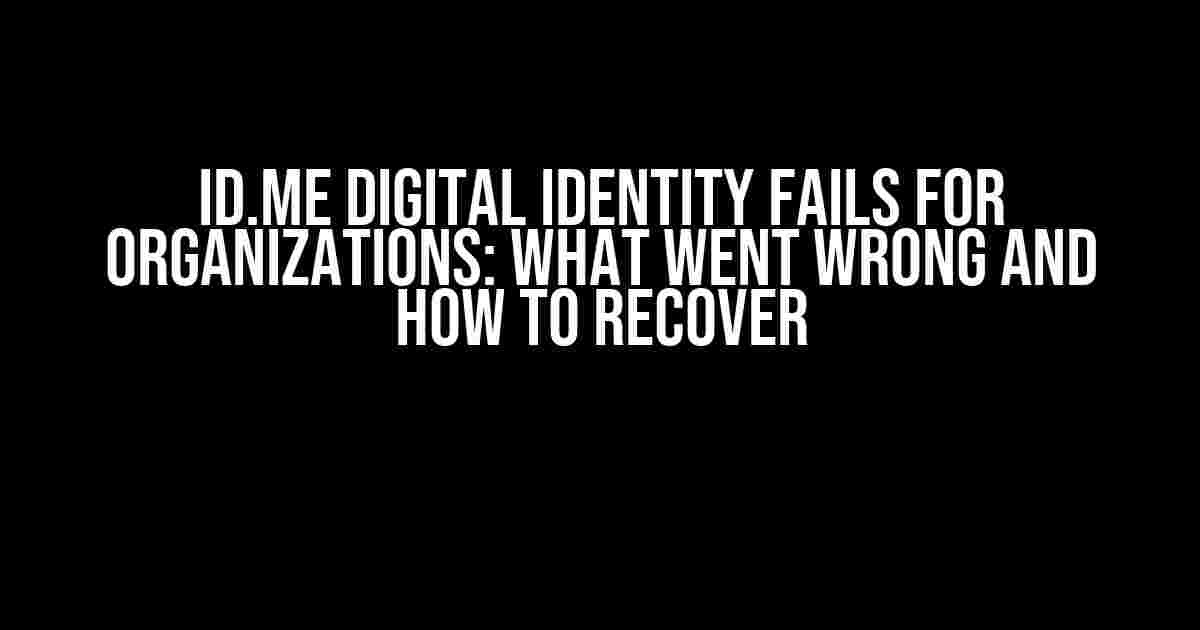As a pioneer in the digital identity space, ID.me has been a trusted solution for many organizations worldwide. However, recent reports have highlighted a concerning trend: ID.me digital identity fails are on the rise, leaving organizations vulnerable to security breaches and reputational damage. In this article, we’ll delve into the reasons behind these failures, explore the consequences, and provide actionable steps to help organizations recover and protect their digital identity.
What Causes ID.me Digital Identity Fails?
ID.me digital identity fails can be attributed to a combination of factors, including:
- Weak Password Management: Passwords are the first line of defense against unauthorized access. Weak passwords, phishing attacks, or poor password management practices can lead to compromised accounts and identity failures.
- Lack of Multi-Factor Authentication (MFA): Not implementing MFA leaves accounts susceptible to hacking, even if passwords are strong. MFA adds an extra layer of security, making it more difficult for attackers to gain access.
- Inadequate Identity Verification: Inaccurate or incomplete identity verification processes can lead to fake or stolen identities, compromising the entire system.
- Insecure Data Storage: Storing sensitive data in unencrypted or unprotected storage can lead to data breaches, putting users’ personal information at risk.
- Insufficient Employee Training: Uneducated or unaware employees can unintentionally compromise digital identities through phishing scams, social engineering, or human error.
Consequences of ID.me Digital Identity Fails
The consequences of ID.me digital identity fails can be severe and far-reaching:
- Security Breaches: Compromised digital identities can lead to unauthorized access to sensitive data, systems, and networks.
- Reputational Damage: Identity failures can erode customer trust, leading to financial losses, legal liabilities, and damage to the organization’s reputation.
- Financial Losses: Cyber attacks and identity theft can result in financial losses, including stolen funds, intellectual property, and sensitive data.
- Compliance Issues: Failure to protect digital identities can lead to non-compliance with regulatory requirements, resulting in fines, penalties, and legal action.
- User Experience: Identity failures can cause inconvenience, frustration, and anxiety for users, ultimately affecting customer satisfaction and loyalty.
Recovery and Protection Strategies
To recover from ID.me digital identity fails and protect against future incidents, organizations should implement the following strategies:
Password Management Best Practices
// Implement a password manager to generate and store unique, complex passwords
// Enforce password rotation every 60-90 days
// Require strong passwords with a mix of characters, numbers, and special characters
Multi-Factor Authentication (MFA)
| Type of MFA | Description |
|---|---|
| Something you know (e.g., password, PIN) | Uses something the user knows to verify their identity |
| Something you have (e.g., smartphone, token) | Uses a physical device or token to verify identity |
| Something you are (e.g., biometric data) | Uses unique physical characteristics to verify identity |
Identity Verification and Authentication
Implement robust identity verification processes, including:
- Know Your Customer (KYC) and Anti-Money Laundering (AML) checks
- Machine learning-based identity verification algorithms
- Trusted identity providers and validation services
Secure Data Storage
// Implement end-to-end encryption for sensitive data
// Use secure protocols for data transmission (e.g., HTTPS)
// Store data in secure, access-controlled environments
Employee Training and Awareness
Provide regular training and awareness programs for employees, focusing on:
- Phishing and social engineering attacks
- Identity theft and fraud prevention
- Best practices for password management and MFA
Conclusion
ID.me digital identity fails can have devastating consequences for organizations. However, by understanding the causes and implementing robust strategies for password management, MFA, identity verification, secure data storage, and employee training, organizations can recover and protect their digital identity. Remember, digital identity security is an ongoing effort that requires continuous monitoring, evaluation, and improvement.
Don’t let ID.me digital identity fails compromise your organization’s security and reputation. Take proactive steps today to prevent identity failures and ensure the trust and loyalty of your customers.
Frequently Asked Question
Having trouble with ID.me digital identity for your organization? We’ve got you covered! Below are some frequently asked questions and answers to help you resolve common issues.
Q1: Why is my ID.me digital identity not being recognized by the organization’s system?
A1: This could be due to incorrect login credentials or an expired identity verification. Try re-verifying your identity and ensure your login credentials are correct. If the issue persists, contact your organization’s IT department for assistance.
Q2: What happens if I forget my ID.me password?
A2: No worries! You can easily reset your ID.me password by clicking the “Forgot Password” link on the login page. Follow the prompts to reset your password and regain access to your digital identity.
Q3: Can I use multiple devices to access my ID.me digital identity?
A3: Yes, you can access your ID.me digital identity from multiple devices, but ensure you’re using the same browser and login credentials. If you’re experiencing issues, try clearing your browser’s cache and cookies before logging in again.
Q4: How do I update my personal information in my ID.me digital identity?
A4: To update your personal information, log in to your ID.me account, navigate to the “Profile” section, and edit your details accordingly. Make sure to save your changes before logging out.
Q5: What if I’m still experiencing issues with my ID.me digital identity after trying the above troubleshooting steps?
A5: Don’t worry! Contact your organization’s IT department or ID.me’s support team for further assistance. They’ll be happy to help you resolve the issue and get your digital identity up and running smoothly.
